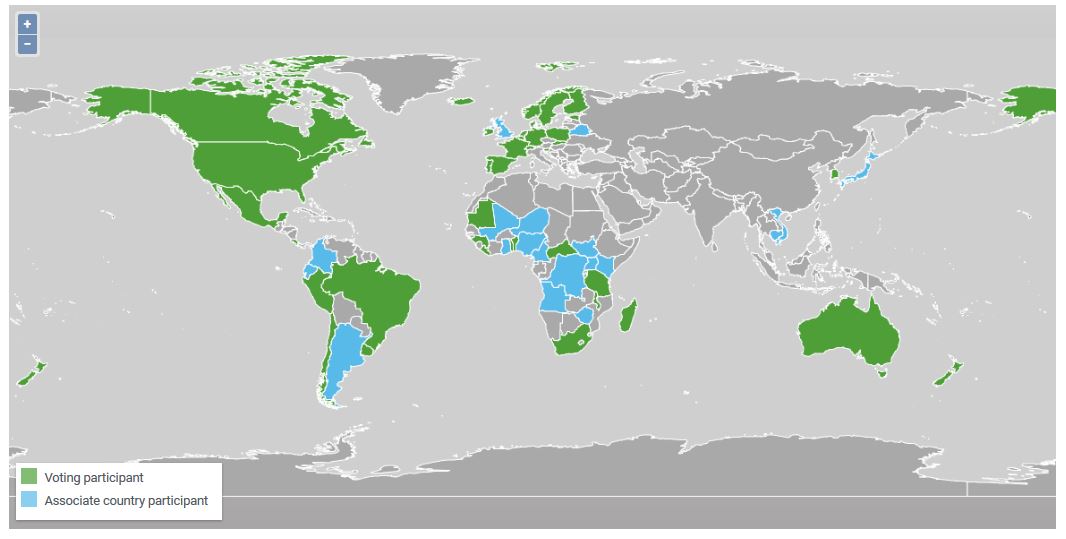|
Sordariomycetes Genera
Sordariomycetes is a class of fungi in the subdivision Pezizomycotina (Ascomycota). It is the second-largest class of Ascomycota, with a worldwide distribution that mostly accommodates terrestrial based taxa, although several can also be found in aquatic habitats. Some are phytopathogens that can cause leaf, stem, and root diseases in a wide variety of hosts, while other genera can cause diseases in arthropods and mammals. The name Sordariomycetes is derived from the Latin ''sordes'' (filth) because some species grow in animal feces, though growth habits vary widely across the class. In 2013, it consisted of 3 subclasses, 12 orders, 600 genera and 3000 species, Then by 2015, it had 3 subclasses, 28 orders, 90 families and 1344 genera. This has increased to 4 subclasses and 54 orders in 2020. It then increased to 6 subclasses and 54 orders in 2023. In May 2023, the GBIF listed 26,295 species in Sordariomycetes. Sordariomycetes generally produce their asci in perithecial fr ... [...More Info...] [...Related Items...] OR: [Wikipedia] [Google] [Baidu] |
Xylaria Longipes
''Xylaria longipes'', commonly known as dead moll's fingers, is a species of fungus in the family Xylariaceae. Taxonomy ''Xylaria longipes'' was first described by the German botanist and mycologist Theodor Rudolph Joseph Nitschke in the first volume of his ''Pyrenomycetes Germanici'', published in 1867. He gave it the name by which it is currently known. ''Xylaria'' is from the Latin ''xulon'', meaning "wood", and ''aria'', meaning "pertaining to", while ''longipes'' is from ''longus'', meaning "long", and ''pes'', meaning "foot". The specific name is in reference to the long stem, which is one of the distinguishing features in contrast to '' Xylaria polymorpha'' (dead man's fingers). In 1958, the English mycologist and plant pathologist R. W. G. Dennis coined the binomial ''Xylosphaera longipes'', resurrecting the Belgian botanist and politician Barthélemy Charles Joseph Dumortier's 1822 genus ''Xylosphaera''. However, the mycological databases MycoBank and Index Fungorum re ... [...More Info...] [...Related Items...] OR: [Wikipedia] [Google] [Baidu] |
GBIF
The Global Biodiversity Information Facility (GBIF) is an international organisation that focuses on making scientific data on biodiversity available via the Internet using web services. The data are provided by many institutions from around the world; GBIF's information architecture makes these data accessible and searchable through a single portal. Data available through the GBIF portal are primarily distribution data on plants, animals, fungi, and microbes for the world, and scientific names data. The mission of the GBIF is to facilitate free and open access to biodiversity data worldwide to underpin sustainable development. Priorities, with an emphasis on promoting participation and working through partners, include mobilising biodiversity data, developing protocols and standards to ensure scientific integrity and interoperability, building an informatics architecture to allow the interlinking of diverse data types from disparate sources, promoting capacity building and cataly ... [...More Info...] [...Related Items...] OR: [Wikipedia] [Google] [Baidu] |
Annulatascales
The Annulatascaceae are a family of fungi in the monotypic order Annulatascales of the class Sordariomycetes of the Ascomycota. The family had not been assigned to any order, until 2020 when it was placed with a new order Annulatascales . Species in this family are saprobic, often found growing on rotten wood in freshwater habitats. They have a widespread distribution, with many found in tropical areas. Genera As accepted by Wijayawardene et al. 2020, 13 genera; *''Annulatascus'' (18 species) *''Annulusmagnus'' (1) *''Aqualignicola'' (2) *''Ascitendus'' (2) *'' Ayria'' (2) *''Cataractispora ''Cataractispora'' is a genus of fungi in the Annulatascaceae family of the Ascomycota. The relationship of this taxon to other taxa within the Sordariomycetes class is unknown (''incertae sedis''), and it has not yet been placed with certainty i ...'' (5) * '' Chaetorostrum'' (1) *'' Fusoidigranularius'' (1) *'' Longicollum'' *'' Longivarius'' (1) *'' Pseudoproboscispo ... [...More Info...] [...Related Items...] OR: [Wikipedia] [Google] [Baidu] |
Biotechnology
Biotechnology is a multidisciplinary field that involves the integration of natural sciences and Engineering Science, engineering sciences in order to achieve the application of organisms and parts thereof for products and services. Specialists in the field are known as biotechnologists. The term ''biotechnology'' was first used by Károly Ereky in 1919 to refer to the production of products from raw materials with the aid of living organisms. The core principle of biotechnology involves harnessing biological systems and organisms, such as bacteria, yeast, and plants, to perform specific tasks or produce valuable substances. Biotechnology had a significant impact on many areas of society, from medicine to agriculture to environmental science. One of the key techniques used in biotechnology is genetic engineering, which allows scientists to modify the genetic makeup of organisms to achieve desired outcomes. This can involve inserting genes from one organism into another, and con ... [...More Info...] [...Related Items...] OR: [Wikipedia] [Google] [Baidu] |
Metabolites
In biochemistry, a metabolite is an intermediate or end product of metabolism. The term is usually used for small molecules. Metabolites have various functions, including fuel, structure, signaling, stimulatory and inhibitory effects on enzymes, catalytic activity of their own (usually as a cofactor to an enzyme), defense, and interactions with other organisms (e.g. pigments, odorants, and pheromones). A primary metabolite is directly involved in normal "growth", development, and reproduction. Ethylene exemplifies a primary metabolite produced large-scale by industrial microbiology. A secondary metabolite is not directly involved in those processes, but usually has an important ecological function. Examples include antibiotics and pigments such as resins and terpenes etc. Some antibiotics use primary metabolites as precursors, such as actinomycin, which is created from the primary metabolite tryptophan. Some sugars are metabolites, such as fructose or glucose, which ar ... [...More Info...] [...Related Items...] OR: [Wikipedia] [Google] [Baidu] |
Biological Pest Control
Biological control or biocontrol is a method of controlling pests, whether pest animals such as insects and mites, weeds, or pathogens affecting animals or plants by using other organisms. It relies on predation, parasitism, herbivory, or other natural mechanisms, but typically also involves an active human management role. It can be an important component of integrated pest management (IPM) programs. There are three basic strategies for biological control: classical (importation), where a natural enemy of a pest is introduced in the hope of achieving control; inductive (augmentation), in which a large population of natural enemies are administered for quick pest control; and inoculative (conservation), in which measures are taken to maintain natural enemies through regular reestablishment. Natural enemies of insects play an important part in limiting the densities of potential pests. Biological control agents such as these include predators, parasitoids, pathogens, and com ... [...More Info...] [...Related Items...] OR: [Wikipedia] [Google] [Baidu] |
Leaf Litter
Plant litter (also leaf litter, tree litter, soil litter, litterfall, or duff) is dead plant material (such as leaves, bark, needles, twigs, and cladodes) that has fallen to the ground. This detritus or dead organic material and its constituent nutrients are added to the top layer of soil, commonly known as the litter layer or O-horizon ("O" for "organic"). Litter is an important factor in ecosystem dynamics, as it is indicative of ecological productivity and may be useful in predicting regional nutrient cycling and soil fertility. Characteristics and variability Litterfall is characterized as fresh, undecomposed, and easily recognizable (by species and type) plant debris. This can be anything from leaves, cones, needles, twigs, bark, seeds/nuts, logs, or reproductive organs (e.g. the stamen of flowering plants). Items larger than 2 cm diameter are referred to as coarse litter, while anything smaller is referred to as fine litter or litter. The type of litterfall is m ... [...More Info...] [...Related Items...] OR: [Wikipedia] [Google] [Baidu] |
Zopfiella
''Zopfiella'' is a genus of fungi within the Lasiosphaeriaceae family. The genus was circumscribed by Heinrich Georg Winter in Rabenh. Krypt.-Fl. ed.2, vol.1 (2) on page 56 in 1884. The genus name of ''Zopfiella'' is in honour of Friedrich (or Friederich) Wilhelm Zopf (1846–1909), who was a well-known German botanist and mycologist. He dedicated to his whole life with fungal biology, particularly in classification of fungi and dye production in fungi and lichens. Species As accepted by Species Fungorum; *'' Zopfiella attenuata'' *'' Zopfiella cephalothecoidea'' *'' Zopfiella ebriosa'' *'' Zopfiella erostrata'' *'' Zopfiella flammifera'' *'' Zopfiella indica'' *'' Zopfiella inermis'' *'' Zopfiella latipes'' *'' Zopfiella lundqvistii'' *'' Zopfiella neogenica'' *'' Zopfiella ovina'' *'' Zopfiella pleuropora'' *'' Zopfiella submersa'' *'' Zopfiella tabulata'' *'' Zopfiella tardifaciens'' *'' Zopfiella udagawae'' Former species; * ''Z. backusii'' = '' Triang ... [...More Info...] [...Related Items...] OR: [Wikipedia] [Google] [Baidu] |
Thielavia
''Thielavia'' is a genus of fungi in the family Chaetomiaceae. Circumscribed by German botanist Friedrich Wilhelm Zopf in 1876, ''Thielavia'' is a teleomorph of '' Myceliophthora''. Collectively, the genus is widely distributed, and according to a 2008 estimate, contained 31 species. '' Thielavia heterothallica'' and '' T. terrestris'' can cause infections in humans. The genus name of ''Thielavia'' is in honour of Friedrich Joachim Sigismund von Thielau (1796–1870), who was a German forester and landowner in Breslau. Species As accepted by Species Fungorum; *'' Thielavia achromatica'' *'' Thielavia ampullata'' *'' Thielavia aurantiaca'' *'' Thielavia australiensis'' *'' Thielavia bispora'' *'' Thielavia coactilis'' *'' Thielavia coerulescens'' *'' Thielavia coprophila'' *'' Thielavia egyptiaca'' *'' Thielavia elliptica'' *'' Thielavia emodensis'' *'' Thielavia expansa'' *'' Thielavia inaequalis'' *'' Thielavia lutescens'' *'' Thielavia macrospora'' *'' ... [...More Info...] [...Related Items...] OR: [Wikipedia] [Google] [Baidu] |
Boothiella
''Boothiella'' is a genus of fungi within the Chaetomiaceae family. This is a monotypic genus, containing the single species ''Boothiella tetraspora''. The genus name of ''Boothiella'' is in honour of Colin Booth (1924 - 2003), a British botanist (mycology) and plant pathologist. He was Deputy Director of the International Mycological Institute (IMI) in Kew. References External links *Boothiella' at Index Fungorum ''Index Fungorum'' is an international project to index all formal names (scientific names) in the fungus kingdom. As of 2015, the project is based at the Royal Botanic Gardens, Kew, one of three partners along with Landcare Research and th ... Sordariales Monotypic Sordariomycetes genera {{Sordariales-stub ... [...More Info...] [...Related Items...] OR: [Wikipedia] [Google] [Baidu] |
Apodus
''Apodus'' is a genus of fungi that was originally placed within the Lasiosphaeriaceae family. In 2020 it was placed within the Neoschizotheciaceae family. Species As accepted by Species Fungorum; *'' Apodus deciduus'' *'' Apodus oryzae'' References External links *Apodus' at Index Fungorum ''Index Fungorum'' is an international project to index all formal names (scientific names) in the fungus kingdom. As of 2015, the project is based at the Royal Botanic Gardens, Kew, one of three partners along with Landcare Research and th ... Sordariales Sordariomycetes genera {{Sordariales-stub ... [...More Info...] [...Related Items...] OR: [Wikipedia] [Google] [Baidu] |


